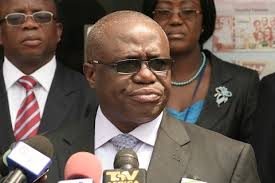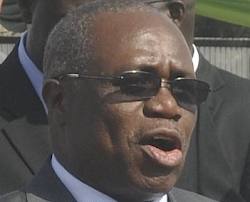 The Bank of Ghana(BoG) has kept its key lending rate at 19 percent.
The Bank of Ghana(BoG) has kept its key lending rate at 19 percent.
Speaking at a news conference in Accra Tuesday, the Governor of the Bank of Ghana, Dr. Henry Kofi Wampah, cited expected inflows from cocoa loan syndication as the main reason for keeping the rates unchanged.
Below is the full statement by the Bank of Ghana
It is my pleasure to welcome you, Ladies and Gentlemen of the media, to this briefing of the 61st regular meeting of the Monetary Policy Committee (MPC). The Committee met to review recent macroeconomic developments and assess the risks to the outlook. I present to you the highlights of the discussions and the decision on the stance of monetary policy.
Global Economic Developments
- The July update of the IMF World Economic Outlook noted that the world economy in 2014 is likely to grow at a slower pace than initially anticipated as a result of weaker growth in the US, China and other emerging markets as well as geopolitical developments in Ukraine, Iraq and the Middle East. Global growth is now forecast at 3.4 percent in 2014, down from the April forecast of 3.7 percent.
-
Growth in the US is projected at 1.7 percent for 2014, rising to 3 percent in 2015, while growth in the euro area is expected to strengthen to 1.1 percent in 2014 and 1.5 percent in 2015 but expected to remain uneven across the region. In emerging markets and developing economies, growth is now projected to decrease to 4.6 percent in 2014 before strengthening to 5.2 percent in 2015.
-
Globally, inflation is expected to stay subdued in 2014–15 with continued sizable negative output gaps in advanced economies, weaker domestic demand in several emerging market economies, and falling commodity prices.
-
While the outlook for inflation in the US remains stable amid an expected growth rebound, falling inflation in the Euro area suggests increasing deflation risks in the outlook. In emerging markets and developing economies, inflation is expected to decline from about 6 percent currently to around 5 percent by 2015.
-
International oil prices have remained relatively stable despite recent tensions in Ukraine, Iraq and the Middle East, with crude oil continuing to trade around US$103.5 a barrel. Gold prices are hovering around US$1,295.5 an ounce while cocoa prices have risen steadily from US$2,746 to US$3,225 per tonne over the first eight months of 2014.
-
The outlook for the rest of 2014 suggests that the price of crude oil could average US$103 per barrel, while that of gold would average US$1,225 per ounce. Cocoa prices are also projected to remain above US$3,000 per tonne.
These developments will have implications for the domestic economy.
The Domestic Economy
Growth and Inflation
- The indications are that the pace of domestic economic activity continued to firm during the second quarter in spite of the ongoing economic challenges. Bank of Ghana’s CIEA for the second quarter of 2014 suggests improved activity relative to the same period in 2013. The index registered a year on year real growth of 10.8 percent at the end of June, 2014, compared with a growth of 3.3 percent for the corresponding period in 2013. The main drivers of the improved economic activity for the period under consideration were domestic VAT and DMBs credit to the private sector.
-
The Bank’s surveys of consumer and business confidence reflected mixed sentiments. The consumer confidence index improved during the August survey, as the index moved to 77.5 from 76.1 in May 2014. The survey respondents were mildly positive about economic prospects.
-
The business confidence index on the other hand indicated continued softening in sentiments. The index dipped from 82.8 in March to 78.6 in June 2014. Among the perceptions cited were: low prospects for improved capital outlay, sales and revenues, negative sentiments on industrial growth and heightened inflation expectations.
-
Since the last MPC meeting, inflation has continued to increase reaching 15.9 percent in August 2014. Non-food inflation rose to 24 percent from 20 percent in May 2014, driven mainly by exchange rate pass-through effects, but food inflation on the other hand eased to 5.1 percent from 8 percent in May.
Monetary Developments
- Broad money (M2+) grew by 35.2 percent year-on-year at end July 2014 to GH¢31.5 billion, compared with a growth of 17.1 percent in the same period last year. The growth in broad money was driven by increases in the NDA of the banking sector. Similarly, the annual growth in reserve money was 42 percent in July 2014, compared with 19.6 percent in July 2013.
12.The banking industry continued to experience steady growth in both nominal and real terms, evidenced by trends in total assets as well as branch expansion across the industry. Total assets increased by 39.7 percent to GH¢44.2 billion in July 2014. Of the total, advances constituted 45.8 percent.
- Credit to the private sector remained strong. In nominal terms, credit to the private sector grew by 46.2 percent in July 2014, compared to 28.1 percent in the same period last year. Real credit growth was 26.8 percent compared to 14.6 percent a year ago. The credit growth was funded mainly by increased mobilisation of deposits by the banking system.
-
Non-performing loans (NPL) ratio adjusted for fully provisioned loans, increased marginally from 5.3 percent in July 2013 to 5.4 percent in July 2014. However, the unadjusted NPL ratio declined from 12.9 percent to 12.3 percent in the same comparative period. The capital adequacy ratio for the banking industry declined to 16.2 percent compared to 18.6 percent in the corresponding period last year, but remained well above the regulatory threshold of 10 percent.
15.Interest rates have generally trended up on the money market between December 2013 and August 2014:
The rate on the 91-day instrument increased to 25 per cent from 19.2 percent. Similarly, that on the 182-day instrument increased to 26.4 percent from 18.7 percent.
The rate on the 1-year note rose to 22.5 percent from 17 percent, and the rate on the 2-year increased to 23 percent from 16.8 percent.
The 3-year bond rate rose to 25.5 percent from 19.2 percent.
- The weighted average interbank rate increased to 24.2 percent from 16.3 percent in December 2013.
-
Average lending rates of the banks rose to 27.8 percent from 25.6 percent in December 2013. The average rate on 3-month term deposits increased marginally to 13 percent from 12.5 percent.
Government Fiscal Operations
- Provisional outturn for broad fiscal performance for the period January-July 2014 suggests an overall budget deficit estimated at 5.3 percent of GDP against a budget target of 5.1 percent, compared to a deficit of 5.6 percent in the same period in 2013.
-
Total revenue and grants was GH¢13.3 billion, against a budget target of GH¢14 billion. Of this outturn, domestic revenue was GH¢12.9 billion, below the target of GH¢13.3 billion. Total tax revenue amounted to GH¢10.2 billion, lower than the target of GH¢10.5 billion and non-tax revenues was GH¢2.6 billion, compared to the budgeted target of GH¢2.7 billion.
-
Total expenditures, including payments for the clearance of arrears and outstanding commitments, amounted to GH¢19.3 billion, lower than the target of GH¢19.8 billion. Compensation of employees was GH¢5.9 billion compared to a target of GH¢6.3 billion. Interest payments totaled GH¢3.7 billion, against a target of GH¢4 billion.
-
The deficit of GH¢6.1 billion was financed mainly from domestic sources, resulting in a Net Domestic Financing (NDF) of GH¢4.8 billion, higher than the budget target of GH¢4.2 billion. Foreign financing of the budget amounted to GH¢1.3 billion, higher than the target of GH¢1.2 billion.
22.The stock of public sector debt as at end of June 2014 was 55.4 percent of GDP, marginally lower than the 55.5 percent observed at the end of December 2013. Of the total public sector debt, domestic debt constituted 43.9 percent and external debt was 56.1 percent.
External Sector Developments
23.For the first eight months of the year, merchandise exports was estimated at US$9 billion, compared to US$9.4 billion in the same period last year. This was mainly due to lower gold export earnings of US$2.9 billion compared to US$3.4 billion in the corresponding period of 2013. Exports of cocoa beans, on the other hand, increased to US$1.4 billion from US$1.2 billion, due to higher volumes. Oil exports remained virtually unchanged at US$2.6 billion, while earnings from non-traditional exports (including cocoa products) declined marginally by US$44.9 million to US$2.1 billion.
- Total imports for the review period fell significantly to US$9.5 billion from US$11.7 billion in 2013. Oil imports fell by 10 percent to US$2.3 billion while non-oil imports declined by 22 percent to US$7.2 billion. These developments resulted in a provisional trade deficit of US$495 million compared to a deficit of US$2.2 billion a year ago.
25.For the first half of the year, the overall balance of payments recorded a deficit of US$1.5 billion compared to a deficit of US$677 million in the same period last year. The current account deficit narrowed to US$2 billion from US$2.3 billion in the same period of 2013. This was as a result of an improvement in the trade deficit and net private transfers. The capital and financial accounts registered lower net inflows of US$479 million compared with US$1.5 billion recorded same period last year.
- Gross international reserves as at end-August, 2014 was estimated at US$4.2 billion, equivalent to 2.4 months of import cover, as against US$5.6 billion or 3.1 months of import cover at the end of 2013.
-
During the first eight months of the year, the local currency depreciated by 29.8 percent against the US dollar on the interbank market, compared to 3.9 percent in the same period last year.
Summary and Outlook
-
In considering the risks to growth and inflation, the Committee noted that global growth remained weak but is expected to rebound. Commodity price movements remained mixed. In particular, gold prices have marginally lost ground. However, cocoa prices have recovered which is a positive development for the external sector going forward.
-
On the domestic front, fiscal pressures and the volatilities in exchange rates continued to pose challenges to the economy. This notwithstanding, the latest numbers suggest some stability in the foreign exchange market as the earlier policy measures including the cumulative 300 basis points increase in the monetary policy rate, the 200 basis points increase in the cash reserve ratio as well as the narrowing of the net open positions of banks work through the system.
-
In addition, the expected inflows from the Eurobond and the cocoa syndicated loan will provide liquidity on the foreign exchange market. Also, the government’s fiscal consolidation efforts are expected to be strengthened under the IMF programme which will also provide additional balance of payments support.
-
The Committee observed softened business confidence and heightened inflation expectations. However, the CIEA showed strong growth on the back of real private sector credit growth with modest improvement in consumer confidence.
-
The growth outlook is generally positive based on expected higher cocoa and oil output. In addition, the gas production which is expected to come on stream from the latter part of the year will help address some of the challenges in the energy sector.
-
In assessing the inflation outlook, the Committee observed that inflation is expected to peak in the near term. The latest forecast showed that inflation is likely to stay slightly above the upper band of the revised target of 13±2 percent by end 2014. However, inflation is expected to move within the band in the second half of 2015 barring any adverse shocks.
-
Given these considerations, the Committee decided to keep the monetary policy rate unchanged at 19 percent. The Committee will continue to monitor developments and take appropriate action when necessary.





